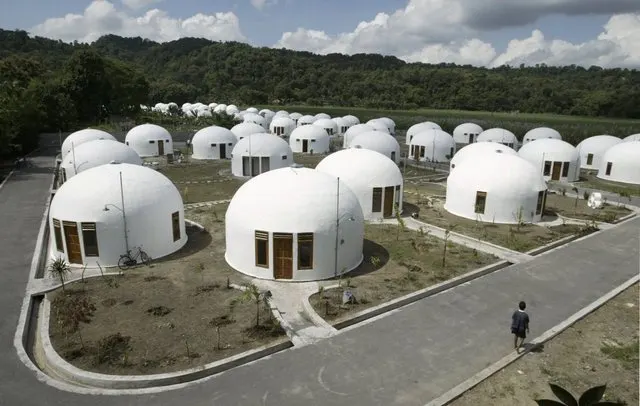The Philippines was hit with the Mother of all Typhoons in November of 2013. With death tolls in the thousands and over a million people displaced from their homes, Typhoon Yolanda was one of the worst typhoons ever recorded.
From Wikipedia:
Typhoon Haiyan, known in the Philippines as Typhoon Yolanda, was one of the strongest tropical cyclones ever recorded, devastating portions of Southeast Asia, particularly the Philippines, in early-November 2013.[1] It is the deadliest Philippine typhoon recorded in modern history,[2] killing at least 6,300 people in that country alone.[3] Haiyan is also the strongest storm recorded at landfall, and the strongest typhoon ever recorded in terms of one-minute sustained wind speed.[4][5] As of January 2014, bodies were still being found.[6]
Ye gods! What a monster!
With the Earth’s climate rapidly changing, we can only expect more of these monster storms, but fortunately, science and engineering is coming to the rescue!
Monolithic home builders out of Texas has designed a simple dome shaped house fortified with basalt that can withstand up to 400km winds which should protect them from another Yolanda. Though, if Yolanda has a big sister, then the Philippines might just become that-collection-of-islands-where-people-once-lived.
“We use basalt (rock derived from lava) as the main strengthening component in building monolithic dome houses. It cannot be destroyed by super typhoons, earthquakes, or fires,” said Michael Scott, Philippine Country Manager of Monolithic home builders based in Texas, United States.
He said the technology is totally green. Basalt will be melted at 2,000 degrees Fahrenheit (1093ºC). Strands that are 6-12 microns thin will then be pulled out, banded together, and ran through and adhesive.
“Then we will use it as the reinforcing material,” Scott said.
“About basalt, well a third of Earth has basalt,” he added.
Scott told Rappler that they are eyed by the government to build monolithic dome houses in places hit by Super Typhoon Yolanda (Haiyan). Dapitan, however, will be the first to have such housing due since the local government is aggressive in having the technology.”
Source: Rappler.com
The design is roomy and simple. With 4 bedrooms, 2 bathrooms and a den, you couldn’t ask for much more for only $6500 (290,000 Philippine Pesos). Maybe rather than spending $2 million dollars criminalizing the homeless, Hawaii could build build 307 typhoon proof homes for families that can’t afford half-a-million dollar hovels in Honolulu or a plane ticket to Missouri . And, because, you know, it’s an island, and them storms they be a comin’! And they’re a volcanic island, so they’ve got lots of basalt… am I the only one wondering why this isn’t already happening out there?
“I saw on TV a father who said that he was hugging a coconut tree while his children were holding his legs and arms, but were slowly carried away by the surge. That should not have happened. We could have saved more lives if we were prepared for it,” Scott told Rappler.
Scott said the monolithic dome houses they will build in Dapitan are low-cost at P290,000 ($6,500) per unit and it will last for centuries.
“Whether a typhoon comes, tsunami, earthquake, or fire comes, I promise you these structures will remain,” Scott said.
The strength of Yolanda was 320 kilometers per hour (kph) at its peak. At that time, the standard strength of structures set by the Department of Public Works and Highways (DPWH) was at 150 kph.
Now DPWH has raised standard strength of houses to 250 kph, and Scott said monolithic dome houses can withstand typhoons of up to 400 kph.
It is not just the basalt, but also the engineering design that makes it disaster proof. The technology is already a hundred years old, but has not been popular.
“The reason is that there are no big associations behind it than there is in metal. The various conglomerates push for metal and those are the guys that everybody listens to,” Scott said.
“It is not the business point of view that is driving me to introduce monolithic dome houses. The desire to save lives is my driving force. I too have a daughter, and we fathers – like that man who lost his children to Typhoon Yolanda – would do anything to see them grow,” he added.
Source: Rappler.com
Where else could you see these durable, low-cost houses being of benefit? Let us know in the comments!
Could you live in a dome home?
***

